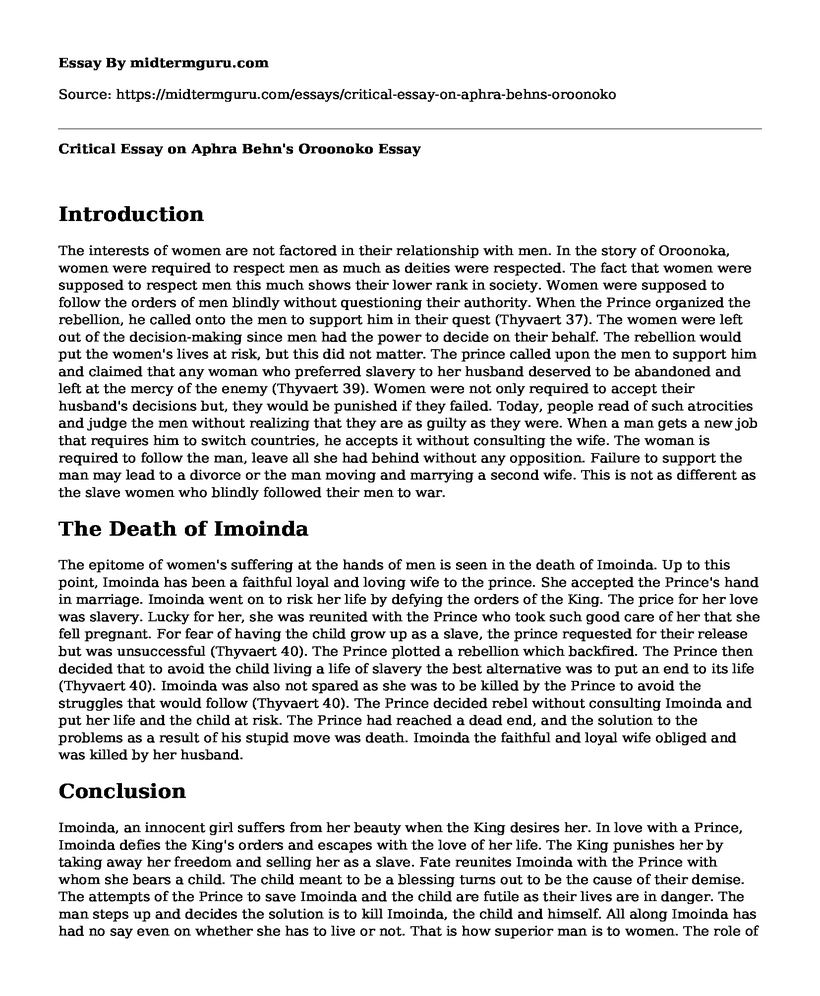Introduction
The interests of women are not factored in their relationship with men. In the story of Oroonoka, women were required to respect men as much as deities were respected. The fact that women were supposed to respect men this much shows their lower rank in society. Women were supposed to follow the orders of men blindly without questioning their authority. When the Prince organized the rebellion, he called onto the men to support him in their quest (Thyvaert 37). The women were left out of the decision-making since men had the power to decide on their behalf. The rebellion would put the women's lives at risk, but this did not matter. The prince called upon the men to support him and claimed that any woman who preferred slavery to her husband deserved to be abandoned and left at the mercy of the enemy (Thyvaert 39). Women were not only required to accept their husband's decisions but, they would be punished if they failed. Today, people read of such atrocities and judge the men without realizing that they are as guilty as they were. When a man gets a new job that requires him to switch countries, he accepts it without consulting the wife. The woman is required to follow the man, leave all she had behind without any opposition. Failure to support the man may lead to a divorce or the man moving and marrying a second wife. This is not as different as the slave women who blindly followed their men to war.
The Death of Imoinda
The epitome of women's suffering at the hands of men is seen in the death of Imoinda. Up to this point, Imoinda has been a faithful loyal and loving wife to the prince. She accepted the Prince's hand in marriage. Imoinda went on to risk her life by defying the orders of the King. The price for her love was slavery. Lucky for her, she was reunited with the Prince who took such good care of her that she fell pregnant. For fear of having the child grow up as a slave, the prince requested for their release but was unsuccessful (Thyvaert 40). The Prince plotted a rebellion which backfired. The Prince then decided that to avoid the child living a life of slavery the best alternative was to put an end to its life (Thyvaert 40). Imoinda was also not spared as she was to be killed by the Prince to avoid the struggles that would follow (Thyvaert 40). The Prince decided rebel without consulting Imoinda and put her life and the child at risk. The Prince had reached a dead end, and the solution to the problems as a result of his stupid move was death. Imoinda the faithful and loyal wife obliged and was killed by her husband.
Conclusion
Imoinda, an innocent girl suffers from her beauty when the King desires her. In love with a Prince, Imoinda defies the King's orders and escapes with the love of her life. The King punishes her by taking away her freedom and selling her as a slave. Fate reunites Imoinda with the Prince with whom she bears a child. The child meant to be a blessing turns out to be the cause of their demise. The attempts of the Prince to save Imoinda and the child are futile as their lives are in danger. The man steps up and decides the solution is to kill Imoinda, the child and himself. All along Imoinda has had no say even on whether she has to live or not. That is how superior man is to women. The role of women in society is to follow, respect and obey. In the end, Imoinda is forgotten. The title of the book bears the name Oroonoka, Imoinda's name is just another character. Just like Imoinda, women continue to live in the shadows of men.
Work Cited
Thyvaert, Hanne. The Sexual Construction of Male and Female Characters in Aphra Behn'sOroonoko, or, the Royal Slave. 2015, https://lib.ugent.be/fulltxt/RUG01/002/213/066/RUG01-002213066_2015_0001_AC.pdf .
Cite this page
Critical Essay on Aphra Behn's Oroonoko. (2022, Oct 19). Retrieved from https://midtermguru.com/essays/critical-essay-on-aphra-behns-oroonoko
If you are the original author of this essay and no longer wish to have it published on the midtermguru.com website, please click below to request its removal:
- Use of Styles by Writers - Paper Example
- Poem Analysis About Alzheimer Disease
- Essay Sample: What Is Alan Moores Argument of Authority in the Watchmen?
- Analysis of A View From the Bridge by Cherokee Paul McDonald - Paper Example
- Literary Analysis Essay on "The Storm" by Kate Chopin
- Critical Essay on Instances of Wisdom and Arrogance in 'Antigone'
- Hamlet Close Reading Essay







